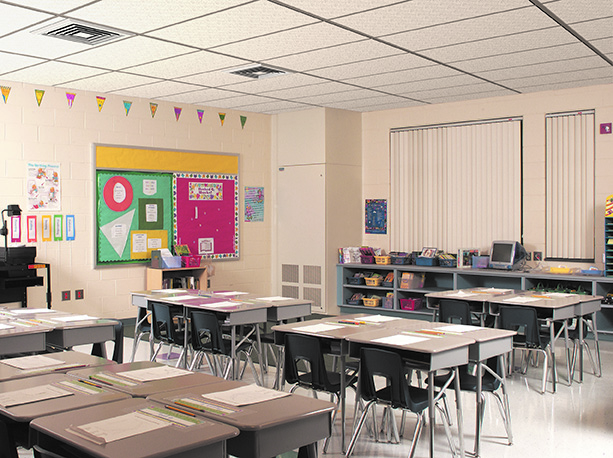Great IAQ Is No Longer Just an Option for K–12 Schools
By Jake Feldman
In the pre-pandemic world, IAQ was often recognized as a best practice for K–12 facilities. While its importance was never in question, there wasn’t much of an emphasis on the vital role it plays in our children’s lives and development. It didn’t make the evening news or create the buzz it does now. The COVID-19 pandemic put a spotlight on the necessity of having clean, comfortable air.
There may be no place where IAQ is more vital than K–12 schools. With students being in close contact with each other throughout the day, airborne pathogens and illnesses can be easily spread throughout the facility. With COVID-19 and the flu posing real threats to schools, no longer is great IAQ just a best practice; it’s a necessity for keeping schools in session.
Respiratory Illnesses and Viruses in K–12 Schools
The pandemic isn’t the only thing that threatens schools’ ability to stay in session. Flu, respiratory, and cold viruses also play a pivotal role. According to the CDC, seasonal influenza activity is high with the CDC reporting 25.1% of clinical labs being positive for influenza in the week ending Dec. 9. With the rapid spread of the flu this year, many districts are in danger of closing for short periods of time. A prime example occurred in Maine early in December. According to Fox 23, two Maine schools were forced to close on Dec. 6 for deep cleaning as respiratory illnesses spread.
The condition also severely affected districts in Kentucky, with at least 26 of Kentucky’s 171 school systems closing or going remote due to widespread illness in November, according to EducationWeek. In the same report, EducationWeek also stated that in November, the Lynchburg-Clay Local School District in Ohio cancelled elementary school and shifted middle- and high-schoolers to remote learning after 20 percent of students were absent because of the flu.
These instances are a prime example of how important providing proper ventilation and filtration solutions are for K–12 schools looking to stay in session throughout the year.

Providing Proper IAQ Solutions
When it comes to equipping schools to combat airborne illnesses, filtration and ventilation are two vital areas of focus. With the goal of keeping schools in session, schools utilize mechanical HVAC solutions to supply clean air within their facilities. This means introducing fresh, outside air into the space while also filtering particulates. In addition, ventilation solutions push contaminated air outside facilities to ensure students and faculty have fresh air to breathe.
Equally as important as introducing fresh air into the classroom is making sure particulates are limited. Filtration systems within HVAC units provide a great defense against these airborne pathogens and allergens. Early during the pandemic, the American Society of Heating, Refrigerating and Air Conditioning Engineers (ASHRAE) laid out the blueprint for filtration by recommending a shift to MERV 13 filters for systems that were compatible.
While mechanical HVAC solutions provide a great defense against airborne pathogens, school districts can add additional upgrades for increased filtration. Needlepoint Bipolar Ionization provides an additional tool to HVAC units to improve IAQ. This solution allows positive and negative ions to be delivered to a classroom through the ventilation system, attach to airborne particulates, cluster, and filter them from the air. This is done without producing other harmful byproducts.
By upgrading filters, school systems are minimizing the number of particulates in the air, which remains important for creating a safe environment for students and faculty.
Keeping Schools Open
An in-person education remains one of the best ways to maximize a child’s ability to learn. K–12 facilities strive to consistently provide this environment, but viruses and other airborne pathogens continue to threaten their ability to stay open. Because of this, enhanced IAQ is no longer a best practice. It’s a must. It is essential for K–12 school leaders to emphasize IAQ to create a collaborative learning environment for students. This means focusing on filtration and ventilation solutions that can combat these pathogens and protect students. Whether it’s utilizing ESSER funds to install a new HVAC unit or to upgrade an existing one, it is paramount that schools have clean air. With comfortable air available for students, K–12 facilities are optimizing the learning environment and displaying a dedication to their students’ success.
Jake Feldman is the vice president, general manager-Indoor Air Quality for Modine Manufacturing Company. At Modine, we are engineering a cleaner, healthier world. Building on more than 100 years of excellence in thermal management, we provide trusted systems and solutions that improve air quality and conserve natural resources. More than 11,000 employees are at work in every corner of the globe, delivering the solutions our customers need, where they need them. Our Climate Solutions and Performance Technologies segments support our purpose by improving air quality, reducing energy and water consumption, lowering harmful emissions and enabling cleaner running vehicles and environmentally-friendly refrigerants. Modine is a global company headquartered in Racine, Wisconsin (USA), with operations in North America, South America, Europe and Asia.